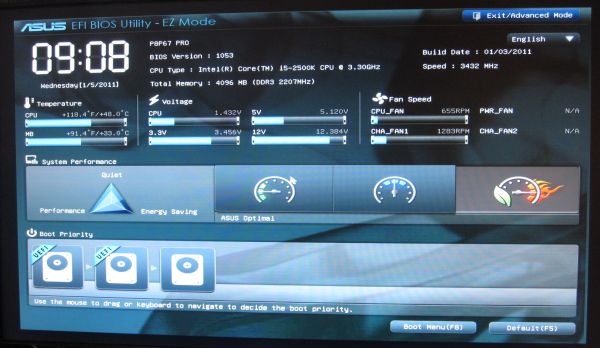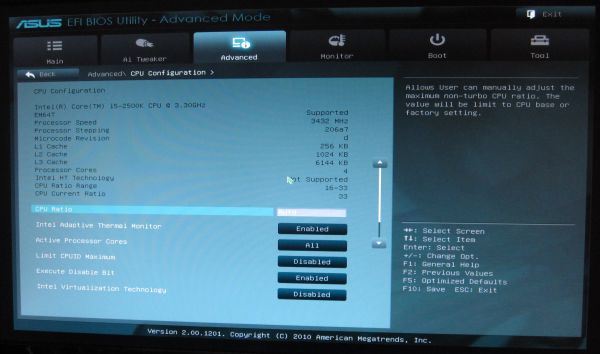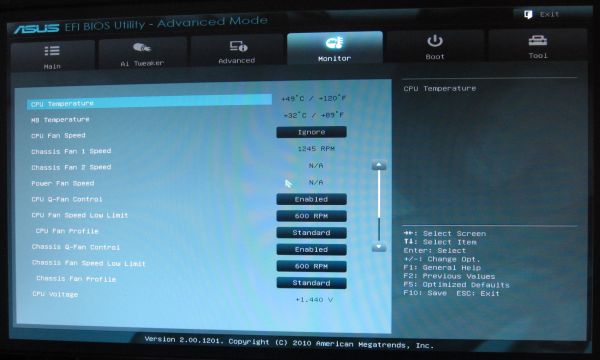The Battle of the P67 Boards - ASUS vs. Gigabyte at $190
by Ian Cutress on January 20, 2011 4:15 PM EST- Posted in
- Motherboards
- Gigabyte
- Asus
- P67
ASUS bring a lot of innovation to the UEFI table over what I have seen from other vendors. The implementation of EZ mode (‘easy’ mode, for us Brits that pronounce that letter ‘zed’) gives the screen below on first entering the UEFI. At a glance, it gives vital motherboard information – CPU, speed, memory, temperatures, voltages, fan speeds, and boot order. The boot order is a great addition, allowing the user to drag-click the order they want. Also available is the three performance options – low power, standard, and performance.
By clicking onto the advanced mode, we get a more BIOS-esque representation of all the motherboard features. The Ai tweaker provides all the overclocking tools we would expect, and more than you find in the Ai Suite in the OS. Features use either a text box for typing values, or a selection box for preset values. The user can utilise the mouse or the keyboard for either task.
Elements such as enhanced sleep states appear under the Advanced CPU Configuration menu, where cores and ratios can be determined. In the Onboard Devices section, if you are not using the Marvell SATA ports, it is advised that this be switched off, to increase boot time by 1-2 seconds.
Fan controls are found in the Monitor tab, where a low limit fan RPM can be given and fan control can be switched between standard/silent/turbo/manual. In manual mode, you can adjust the upper and lower temperature of the fan and at which percentage speed it should run at those temperatures.
Users can specify advanced mode to be shown as soon as the UEFI is selected, and ten UEFI profiles can be saved. The UEFI can also be updated through the Tools tab if the latest file is supplied on a USB drive and plugged in before the ‘update’ option is chosen.
Overclocking
Overclocking on the P8P67 Pro was easy. The UEFI EZ mode offers a performance mode option, which on selecting, enabled the XMP profile of the memory, applied a 103 BCLK, and set the turbo limit to 42x, giving a 4.33 GHz overclock.
As the Ai Suite offers the ‘Auto Tuning’ option, I selected this in the OS and let the program do its thing. After a couple of reboots, and a BSOD, the OS booted into a screen showing a 43x multiplier at 103.5 BCLK (4.45 GHz), and attempted a series of stability tests, slowing increasing the BCLK by 0.5 every 30 seconds. At 105.5 BCLK, a BSOD screen appeared and seemed to crash halfway through, requiring me to reset the system physically. On the next boot, it was stated that the 43x103.5 overclock was applied and now usable. This system is likeable as it promises to adjust depending on how overclockable the processor is.
The downside is that the Ai Suite is quite conservative. I kept with the 103.5 BCLK and went into the UEFI. In advanced mode, adjusting the turbo ratio by one each time and rebooting led to a 46x multiplier (4.76 GHz) successfully passing stability tests. For 47x multiplier (4.86 GHz), I increased the PLL to 1.9V, CPU VCore to 1.42 V, and adjusted the short/long power limits to 150 W/130 W to get a successful stability test pass. This automatically set the memory to a command rate of 3T, so was set back to 1T manually. The 48x multiplier did not boot at this level, and I was not prepared to up the VCore or power limits any more. A 4.86 GHz overclock is very respectable!
At 4.86 GHz (47% OC over 3.3 GHz/non turbo/multithreaded, 31% OC over 3.7 GHz/turbo/single-threaded), the 3D Movement benchmark was run. In single thread mode, a score of 148.92 was achieved, a 31% increase. In multi-threaded mode, a score of 477.60 was achieved, a 37% increase.




















137 Comments
View All Comments
James5mith - Friday, January 21, 2011 - link
One big giant reason to use the Asus board? Intel® 82579 Gigabit EthernetAn Intel PHYS on an Intel board means one less PCIe lane taken up by the NIC. Not to mention, it's Intel not Realtek.
Mumrik - Friday, January 21, 2011 - link
‘if I’d rather take a $150 board rather than a $190 board, why are there $300 boards available?’No, the question is why you don't focus more on reviewing the lower end boards. Motherboards have become too expensive, especially when you consider how much is being moved onto the CPU. These were Asus' and Gigabyte's midrange boards. I'd love to hear more about the two below them in the two companies' lineups. Let's hear if there's a reason not to pick the 130-150 options.
erple2 - Friday, January 21, 2011 - link
I think the question is still extremely valid - if the 150 dollar board gives you all of the performance of the 190 dollar boards, where does that leave the 300 dollar boards?You also bring up another good question - what can the 150 dollar board buy you that the 100 board doesn't have?
My assumption is that there are various features that simply don't exist on the sub-100 dollar boards.
BTW, I'm not sure that motherboards are really all that expensive. At least, not beyond "standard inflation". The same level of features (of the day) cost about the same amount as they do today, I think.
7Enigma - Tuesday, January 25, 2011 - link
If this is standard inflation we are in for a world of hurt....sweetspot - Friday, January 21, 2011 - link
Just me but id prefer 70fps in my games if sound quality was excellent vs 75-80 FPS and unusable sound mobo parts. And or have to pay additional for add on pci sound card cash which defeats the savings shown using the asrock 150 mobo yet sounds bad so pay 50-70 more for add on card, vs the 2 190 boards sounds are good, So the value set he describes in this review of the 40 dollar cheaper board is totaly stupid since he failed to show the boards major components correctly ( Yes sound on a mobo is consider a major component piece of the many).Sure reader can go elsewhere to get the info but the point of the review sites is to cover basic parts so people dont have to web hop all day for those details.
faxon - Friday, January 21, 2011 - link
I wanna see a review of these vs the P67-GD65 from MSI. its the cheapest 8 SATA port board on the market and other sites have been saying it looks pretty good, wondering what you guys think before i buy it thoughHauntFox - Friday, January 21, 2011 - link
I just built a new system with this Asus board, it is quite nice, except I do not like the sata ports that point to the front. I barely have enough room to plug a sata cable into them with my case because the drive cage is in the way.RussianSensation - Friday, January 21, 2011 - link
Legit Reviews did a comparison, which can be found here: http://www.legitreviews.com/article/1500/1/1) Realtek vs. Intel - Besides a 3% lower CPU performance, the throughput is hardly any better wtih Intel. Also, unless you are networking multiple computers, we aren't going to be hitting 900+MB/sec in Internet speed.
2) 16x/4x vs. 8x/8x in CrossFire - Since P67 chipset runs PCIe 2.0 at full speed unlike P55 chipset, the PCIe 4x slot off the P67 chipset actually has 2x the PCIe bandwidth compared to P55 16x/4x boards. Overall, when testing with HD6950s in CF, the performance difference is almost nonexistent.
So overall, the stock P8P67 board looks like the one to get for those running single-GPUs.
Exodite - Monday, January 24, 2011 - link
I'd get the ASUS just for the Intel LAN solution TBH.I can't say whether it's hard- or software, or a combination of the two, but Realtek ended up as a real step down from the Marvell solution in my previous motherboard and I'd avoid it in the future if I can.
Most notably I went from a 30-40ms latency in WoW to 100-120ms with the Realtek. This was only recently rectified, well mostly rectified, with a driver update.
So for me personally i'd definitely be worth it. It's nice to see a review that tests the LAN solutions but frankly just testing throughput and CPU usage is rather disingenuous as latency and jitter probably play a larger role in most network-related usage.
fixxxer0 - Saturday, January 22, 2011 - link
how come there are no tests showing the SATA 6.0 speed comparisons?